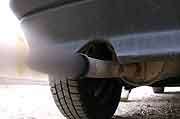Exposure to traffic-related air pollution, including nitrogen dioxide and particulate matter less than 2.5 and 10 micrometers in diameter, during gestation and the first year of life is associated with a significantly increased risk of autism, according to research published in the January issue of JAMA Psychiatry.
(HealthDay)—Exposure to traffic-related air pollution, including nitrogen dioxide and particulate matter less than 2.5 and 10 micrometers in diameter (PM2.5 and PM10), during gestation and the first year of life is associated with a significantly increased risk of autism, according to research published in the January issue of JAMA Psychiatry.
In an effort to examine the association between traffic-related air pollution, air quality, and autism, Heather E. Volk, Ph.D., M.P.H., of the University of Southern California in Los Angeles, and colleagues conducted a population-based, case-control study involving 279 children with autism and 245 control children with typical development.
Compared with control children, the researchers found that children with autism were significantly more likely to live at residences with the highest quartile of traffic-related air pollution exposure during gestation and the first year of life (adjusted odds ratios, 1.98 and 3.10, respectively). Specific exposure to nitrogen dioxide and PM2.5 and PM10 were also significantly associated with autism during gestation and the first year of life.
"Exposures to traffic-related air pollution, PM, and nitrogen dioxide were associated with an increased risk of autism," the authors write. "These effects were observed using measures of air pollution with variation on both local and regional levels, suggesting the need for further study to understand both individual pollutant contributions and the effects of pollutant mixtures on disease."
Two authors are employees of Sonoma Technology; one author disclosed financial ties to British Petroleum.
More information:
Abstract
Full Text (subscription or payment may be required)
Editorial (subscription or payment may be required)
Copyright © 2013 HealthDay. All rights reserved.


















